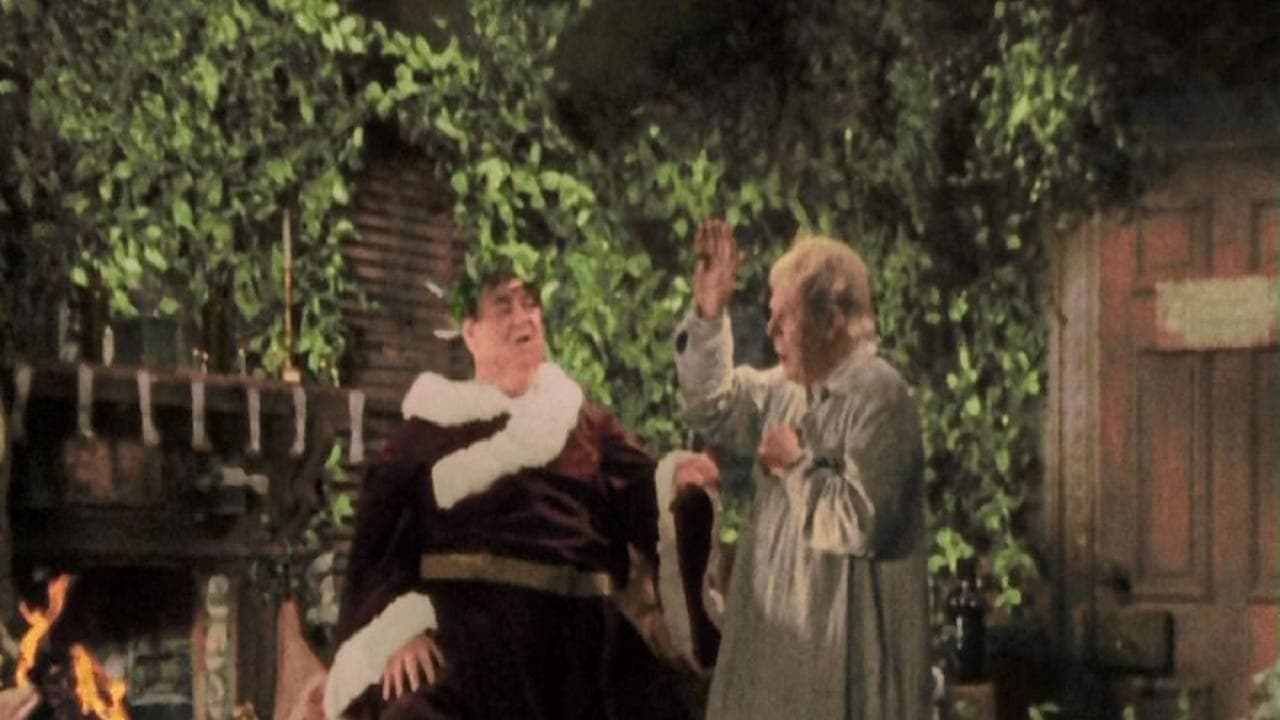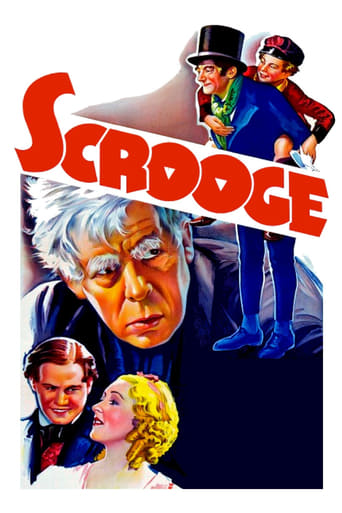

If there's a lesson to be learned from the countless adaptations of A Christmas Carol, it's that the makers should stick to the text as closely as possible. Dickens barely wasted a word in his novella; it being a perfectly judged, perfectly paced bit of fiction.This adaptation takes a few wrong turns. It takes far too long before we get to the actual haunting, with the first 30 minutes being positively meandering. There's also a perfunctory sequence, featuring none of the main characters, where the King is celebrated. Maybe this kind of thing pleased the masses back in the thirties, but it does make the opening act a bit of a slog.One would hope that things would get back on track when Jacob Marley appears. Unfortunately, Jacob Marley doesn't appear at all; he's a rather unimpressive voice-over. It's an odd choice; as if the makers aren't confident enough to give us a character design that will work for us.Unfortunately, the sequence following this isn't much better. The visit from The Ghost of Christmas Past is done and dusted in less than 5 minutes (I'm not exaggerating). There's nothing of Scrooge of a boy, no mention of Fezziwig and we only really see the break-up of his relationship with Belle (and nothing of the good times Scrooge shared with her). This is a major misstep; as it fails to adequately give us Scrooge's backstory. Considering what *is* included in this adaptation, it's baffling that such a key segment was skipped over. I'm wondering if it was abridged so that they'd be no need for other, younger actors to play Scrooge, but that seems like an unnecessary compromise.The Present and Yet To Come sequences fare better, and the conclusion to the story is really rather good as adaptations of the novella go. However, the damage has already been done.It's a big shame as the cast are fine. Seymour Hicks may be a touch too shabby for my tastes as Old Scrooge, but he's able to give us a decent contrast in his performance (even if his redemption is far too quick, and seems almost complete after a quick glimpse at his past).In summary, this is probably on an even footing with the Reginald Owen offering from just three years later (1938). Both have as many flaws as aspects to recommend, but both are worth a watch to aficionados of the classic story.
... View MoreIs it even possible that there could be a bad production of "A Christmas Carol?" The beloved tale of greed and meanness converting to kindness and charity is the most famous of all modern Christmas holiday stories. And the Charles Dickens classic has been performed thousands of times on stage and over the air, and many times on film. That answers the question I posed above. With such a great story and any effort to produce it well, a bad "Christmas Carol" production isn't likely to occur. But, surely, some must be better than others. For purposes of comparing film versions, what remains for us to be able to judge them is the differences in the script, in the technical production, in the cast and in the performances of the individual actors. This "Scrooge" is the first production of the Dickens classic on sound film. Its emphasis is heavily on the main character. And, for that reason, it is a good film to keep in a library, along with two other later versions. That's because of who plays Scrooge. Seymour Hicks was Ebenezer Scrooge before movies were made. That is to say, he was the actor known and renowned for his many performances of Scrooge on stage. He first played Scrooge in 1901. He specialized in the role, and as a young actor bore the criticism of not looking old enough. Hicks was an accomplished actor of comedy and drama. He is credited with having done thousands of performances of "A Christmas Carol" over the years. He made the first silent film, "Old Scrooge" in 1913. Hicks was the 13th English actor to be knighted. He was a prolific writer for the stage, with 64 plays and productions to his credit. He wrote comedy musicals for him and his wife to perform. His plays were so successful that he was able to build two theaters. The first, in 1905, was the Aldwych Theatre. In 1906, he built the Seymour Hicks Theatre – now called the Gielgud Theatre. Jerome Kern wrote the musical score for his first successful musical comedy – "The Beauty of Bath," in 1906. Hicks helped discover Alfred Hitchcock. During both world wars, Hicks entertained Allied troops in France and elsewhere. He twice received the French Croix de Guerre. In this production of the Dickens Classic, Hicks was 64 years old, and he naturally looked for the part. He surely is the darkest of all the Scrooge roles on film. He seems to be a sinister character who relishes his tyrannical nature. This film has the dark trappings of early films all around him. They add to the heaviness of the scene. But they also haze over the fringes of scenes and people. This film is 78 minutes in length. While Scrooge is the main character of the Dickens tale, his conversion comes about by what the spirits show him of other people. And this film doesn't develop those enough to give the story its full impact. Without that, and with the Hicks' Scrooge so hardened in his ways, it's not as convincing when his heart changes. The production values of the old print I have on DVD are not very good. Still, it is a worthy part of a Dickens movie collection for this early rendition of Ebenezer Scrooge by one of the early English actors to be known for the role.
... View MoreI've never warmed to this version of A Christmas Carol, probably because I've been spoiled by the wonderful Alastair Sim version. While I find Hicks' portrayal of Scrooge to be quite good and believable, the production itself feels a bit raced through - because it's missing 18 minutes of footage from the original version! - and is lacking human warmth. It's also quite a drawback that there are no special effects at all to speak of when it comes to the portrayal of the spirits. Old Marley's ghost isn't even seen, and the Ghosts of Xmas Past and Future are pretty basic. The opening of the film is quite good in establishing a real feel for London of the 1840s, especially with the not-refined playing of the amateur street band.The blu-ray brings a bit of improvement to the DVD version I own as part of VCI's "UCE" of the Alastair Sim version (which - like the BD under review - is also the 60-minute "cut" version of the 78-minute original). The included colorized version is so drab as to not seem to be in color at all. Little if any effort has been made to clean up or sharpen the film's image, though the soundtrack is relatively quiet for such an old film.Still, it's good to have different versions of this classic story available on film. I would certainly rank this production higher that the horrible George C Scott version, which is over-produced to within an inch of its life, and which has in Scott possibly the worst portrayal of Scrooge ever set down on film.Okay and nothing more.
... View MoreA long way from the best version by all means, the Alastair Sim and George C. Scott films are the definitive versions as adaptations and as stand alones. It's not the worst either, that dishonour goes to the 2001 animated film. It is interesting historically for being the first non-silent version as well as being one of the earliest, but for all the rather big flaws Scrooge(1935) has it is worth watching for more than just historical interest.I did find that there was a lot wrong with Scrooge. The camera work is rather static and could have been much more expansive, giving the film a stage-bound look sometimes. The music score is not bad-sounding at all, in fact it is quite nice and captures the Christmas spirit very well, the problem is that it is too intrusive making some of the dialogue not as audible as it could have done. While Scrooge isn't interminably dull as such, there was some padding that could have been shortened or left out entirely, there was a preparation for a feast scene that was one of the better-looking scenes of the film but took too long and was rather unnecessary. And unfortunately the ghosts were disappointing; the best special effect is the subtle and quite creepy one of Jacob Marley's ghostly face appearing on the door-knocker. The Marley scene did disappoint to some extent, the scene is too brief and does lack tension and Marley being just a disembodied voice looked strange and felt it too, the dialogue is good and though and Marley himself is beautifully voiced(such a shame the actor, sounding eerily like Claude Rains, is uncredited). Ghost of Christmas Past is just a blur and here Scrooge's past is very underdeveloped to the extent that it seems like Scrooge always was a miser(we are never shown why Scrooge resents his nephew Fred so much), making his redemption less believable. Just as bad is Ghost of Christmas Future, who is little more than a shadow on the wall who does very little other than point. Only Ghost of Christmas Present is seen properly and has proper screen time and his portrayal by Oscar Asche is a mixed bag, Asche does have some entertaining moments, but his portrayal is rather too slovenly(more Falstaff than Ghost of Christmas Present) and was in need of more robustness, at other points he also over-compensates.From the sounds of it it sounds like Scrooge is a bad film but it doesn't, just badly flawed. Scrooge does have many good merits. The best being Seymour Hicks's Scrooge, who is delightful as the character. Scrooge as a miser has rarely been scarier on film, and in an effective way, yet his redemption was quite charmingly done. Donald Calthrop gives one of the better portrayals of Bob Cratchit, cheerful and humble but under the smile there was a real fragility that Calthrop shows poignantly. It was nice to see more of Fred and Robert Cochran is most amusing, always with a cheerful air, even when his uncle resents him as much as he does. Phillip Frost is a cute and moving Tiny Tim. The Cratchit scene(s) have a danger of being overly-sentimental, here they were heart-warming and bring a tear to the eye, anybody can see how much they love each other as a family and can identify with it. One scene really stood out in Scrooge which was with Tiny Tim dead, with his body interestingly being shown, and Bob at his side, it is a heart-breaking scene and Calthrop's acting is part of the reason. The dialogue is very faithful to the book, some scenes almost word for word, and is great dialogue on its own. The story- which has always been one of my all time favourites- is also adapted reasonably faithfully, though with some omissions(mostly with Scrooge's past) and additions, and captures the spirit of the book and of Christmas very well. While the camera work and special effects were left wanting, the costumes and sets are actually very evocative and there's effective use of shadowy lighting.Overall, from a historical perspective Scrooge is very interesting and while there is a lot wrong with it it is an acceptable version that also does a lot right. 6/10 Bethany Cox
... View More